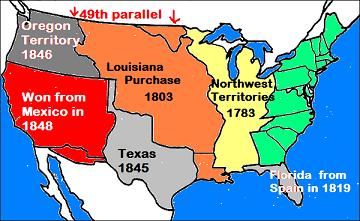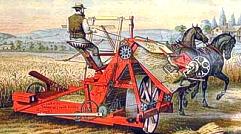STANDARD US1.8a
Westward Expansion
a) describing territorial expansion and how it affected the political map of the United States, with emphasis on the Louisiana Purchase, the Lewis and Clark expedition, and the acquisitions of Florida, Texas, Oregon, and California.
What new territories became part of the United States between 1801 and 1861?
|
Between 1801 and 1861, exploration was encouraged as America underwent vast territorial expansion and settlement. |
|
|
New territories added to the United States after 1801 |
|
|
Louisiana Purchase Jefferson bought land from France (the Louisiana Purchase), which doubled the size of the United States. In the Lewis and Clark expedition, Meriwether Lewis and William Clark explored the Louisiana Purchase from the Mississippi River to the Pacific Ocean. Florida Spain gave Florida to the United States through a treaty. Texas Texas was added after it became an independent republic. Oregon The Oregon Territory was divided by the United States and Great Britain. California War with Mexico resulted in California and the southwest territory becoming part of the United States. |
|
 |
|
STANDARD US1.8b
Westward Expansion -
Geographic and Economic Factors
b) identifying the geographic and economic factors that influenced the westward movement of settlers.
What factors influenced westward migration?
Westward migration was influenced by geography and economic opportunity
Geographic and economic factors that influenced westward movement
Availability of cheap, fertile land
Economic opportunity, e.g., gold (California Gold Rush), logging, farming, freedom (for runaway slaves)
Cheaper and faster transportation, e.g., rivers and canals (Erie Canal), steamboats
Belief in the right of Manifest DestinyThe idea that expansion was for the good of the country and was the right of the country
STANDARD US1.8c
Impact of
Inventions
c) describing the impact of inventions, including the cotton gin, the reaper, the steamboat, and the steam locomotive, on life in America.
How did the inventions affect the lives of Americans?
Prior to the Civil War, most industrialization in America was in the North; however, the equipment produced in the North had an impact on the farming society in the South.
New technologies
|
|
 |
 |
 |
|
The cotton gin was invented by Eli Whitney. It increased the production of cotton and thus increased the need for slave labor to cultivate and pick the cotton. |
Jo Anderson (a slave) and Cyrus McCormick worked to invent the reaper. The reaper increased the productivity of the American farmer. |
The steamboat was invented by Robert Fulton. It provided faster river transportation that connected Southern plantations and farms to Northern industries. |
The steam locomotive provided faster land transportation. |
